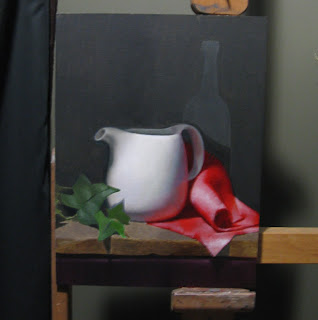1. Tenebrist lighting. The Wikipedia definition of tenebrism is this: "from the Italian tenebroso ("murky"), (also called dramatic illumination) is a style of painting using very pronounced chiaroscuro, where there are violent contrasts of light and dark, and darkness becomes a dominating feature of the image."
2. Something with writing on it.
I choose these objects or "characters":
- a cork lantern with tattered blue cord at its base, propped up on wood blocks
- a piece of old driftwood that looks like a petrified pike with its mouth open (but no teeth)
- red, black, and white cloth from the Ukraine
- an Ontario nature book open at a page showing an image and description of two fish -- a perch and a rainbow trout
- an old wooden fishing lure that is red on the top and has two beady eyes
- a bright yellow/red lure that has seen better days.
I spent 2 Saturday afternoons toying with this set up. In my first composition, the cork lantern was central and the driftwood came out from the right. This time, I shifted the lantern to the right, and then changed some of the diagonals. But the biggest change was the introduction of the yellow jure as the colour anomaly -- an object that doesn't look like it belongs and so when it appears the eye jumps to it.
I've placed my yellow lure slightly off centre and hanging down from the top of the box. My camera on its tripod wasn't at my eye level and it tended to focus on the lure as the closest object, making it seem larger. It's actually smaller! In the final setup, I also changed the positioning of the blue cord and the red lure slightly.



























